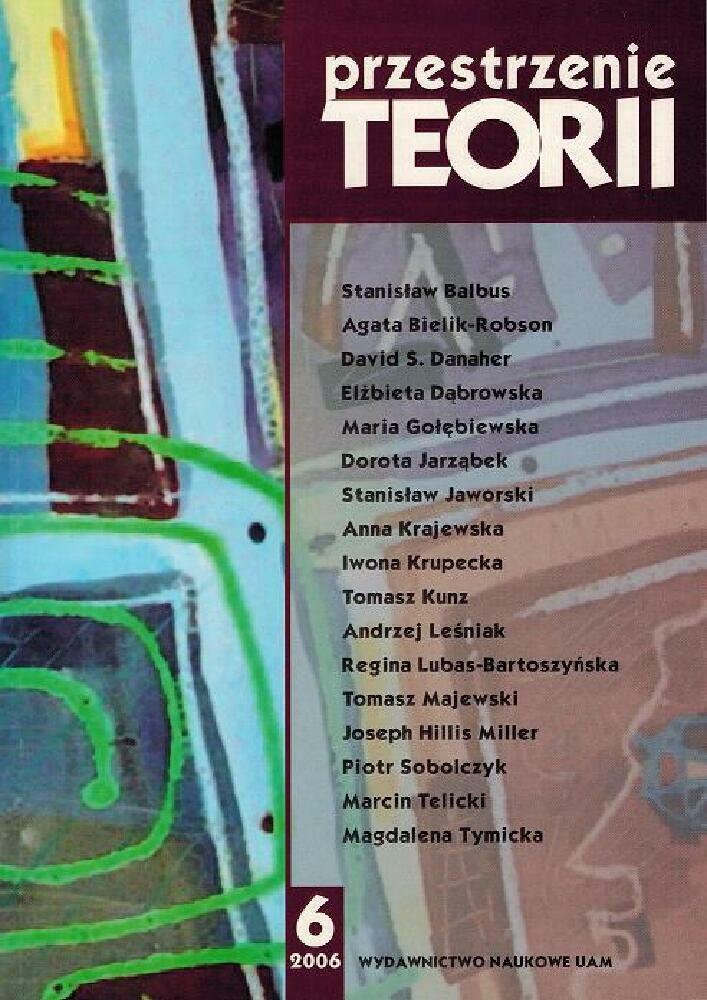Abstract
Poetyka kognitywna a literackość: analogia metaforyczna w Annie Kareninie
References
ADLER, H. and S. Gross 2002. “Adjusting the Frame: Comments on Cognitivism and Literature,”
Poetics Today 23:2, 195-220.
BOOTH, W. 1961. The Rhetoric o f Fiction. Chicago: University of Chicago Press.
DANAHER, D. 2003. “A Cognitive Approach to Metaphor in Prose: Truth and Falsehood in Leo Tolstoy’s ‘The Death of Ivan Il’ich’,” Poetics Today 24:3, 439-469.
DlRVEN, R. 1993. “Metonymy and Metaphor: Different Mental Strategies of Conceptualisation,” Leuvense Bijdragen 82, 1-28.
EDMUNDSON, M. 2004. Why Read'?. New York: Bloomsbury.
ElKHENBAUM, B. 1982. Tolstoi in the Seventies. Ann Arbor: Ardis.
EMERSON, C. 2003. “Tolstoy versus Dostoevsky and Bakhtin’s Ethics of the Classroom,” in Knapp and Mandelker, 104-115.
GAVINS, J. and G. St e e n (eds.) 2003. Cognitive Poetics in Practice. London: Routledge.
GIBBS, R. 2002. “Identifying and Appreciating Poetic Metaphor,” Journal o f Literary Semantics 31, 101-112.
GROSS, S. 1997. “Cognitive Readings; or, The Disappearance of Literature in Mind,” Poetics Today 18:2, 271-297.
GUSTAFSON, R. 1986. Leo Tolstoy: Resident and Stranger. Princeton: Princeton University Press.
HAVEL, V. 1990. “Krize identity [1982],” in: O lidskou identitu, 349-351. Prague: Rozmluvy.
JACKSON, R.L. 1993. Dialogues with Dostoevsky. Stanford: Stanford University Press.
KNAPP, L. and A. Man d e lk er 2003. Approaches to Teaching Tolstoy’s “Anna Karenina”. New York: Modem Language Association of America.
LAKOFF, G. 2004. Don't Think o f an Elephant!. White River Junction, Vermont: Chelsea Green.
LAKOFF, G. and M. TURNER. 1989. More than Cool Reason: A Field Guide to Poetic Metaphor. Chicago: University of Chicago Press.
MANDELKER, A. 1993. Framing “Anna Karenina”. Columbus: Ohio State University Press.
MlALL, D. and D. KUIKEN. 1998. “The Form of Reading: Empirical Studies of Literariness,” Poetics 25: 327-341.
MORSON, G.S. 1978. “The Reader As Voyeur: Tolstoi and the Poetics of Didactic Fiction,” Canadian-American Slavic Studies 12:4, 465-480.
OATLEY, K 1992. Best-Laid Schemes: The Psychology o f Emotions. New York: Cambridge University Press.
ORWIN, D. 2003. “Tolstoy’s Anti-philosophy Philosophy in Anna Karenina,” in: Knapp and Mandelker 2003, 95-103.
PEIRCE, C.S. 1931. The Collected Papers o f Charles Sanders Peirce. Eds. C. Hartshome and P. Weiss. Cambridge: Harvard University Press.
PEIRCE, C.S. 1997. Wybór pism semiotycznych; wyboru dokonała Hanna Buczyńska-Garewicz; [przekł. Ryszard Mirek i Andrzej J. Nowak]. Warszawa: “Znak, Język, Rzeczywistość”: Polskie Towarzystwo Semiotyczne, 1997. Seria Biblioteka Myśli Semiotycznej.
SCHULTZE, S. 1982. The Structure o f “Anna Karenina”. Ann Arbor: Ardis.
SEMINO, E. and J. Culpeper (eds.) 2002. Cognitive Stylistics: Language and Cognition in Text Analysis. Amsterdam: Benjamins.
SlLBAJORIS, R. 1990. Tolstoy’s Aesthetics and His Art. Columbus: Slavica Publishers.
SLOANE, D. 2001. “Rehabilitating Bakhtin’s Tolstoy: The Politics of the Utterance,” Tolstoy Studies Journal 13, 59-77.
STENBOCK-FERMOR, E. 1975. The Architecture o f “Anna Karenina”. Lisse: Peter de Ridder Press.
STOCKWELL, P. 2002. Cognitive Poetics: An Introduction. London: Routledge.
TOŁSTOJ, L.N. 1972. Anna Karenina. Tłum. Kazimiera Iłłakowiczówna. Warszawa.
TOŁSTOJ, L.N. 1936. flonnoe coópmue cohuhchu u . Moscow.
TROLLOPE, A. 1986. The Warden. New York: Penguin.
TSUR, R. 1992. Toward a Theory o f Cognitive Poetics. Amsterdam: North-Holland.
TURNER, C.J.G. 1993. A Karenina Companion. Waterloo, Ontario: Wilfrid Laurier University Press.
TURNER, M. 1996. The Literary Mind: The Origins of Language and Thought. New York: Oxford University Press.
TURNER, M. 1991. Reading Minds: The Study of English in the Age of Cognitive Science. Princeton: Princeton University Press.
ZwiCKY, J. 2003. Wisdom & Metaphor. Kentville, Nova Scotia: Gaspereau Press.
License
Authors
Authors of texts accepted for publication in Przestrzenie Teorii are required to complete, sign and return to the editor's office the Agreement for granting a royalty-free license to works with a commitment to grant a CC sub-license.
Under the agreement, the authors of texts published in Przestrzenie Teorii grant the Adam Mickiewicz University in Poznań a non-exclusive, royalty-free license and authorize the use of Attribution-NonCommercial-NoDerivatives 4.0 International (CC BY-NC-ND 4.0) Creative Commons sub-license.
The authors retain the right to continue the free disposal of the work.
Users
Interested Internet users are entitled to use works published in Przestrzenie Teorii since 2015, for non-commercial purposes only, under the following conditions:
- attribution - obligation to provide, together with the distributed work, information about the authorship, title, source (link to the original work, DOI) and the license itself.
- no derivatives - the work must be preserved in its original form, without the author's consent it is not possible to distribute the modified work, such as translations, publications, etc.
Copyrights are reserved for all texts published before 2015.
Miscellaneous
Adam Mickiewicz University in Poznań retains the right to magazines as a whole (layout, graphic form, title, cover design, logo etc.).
